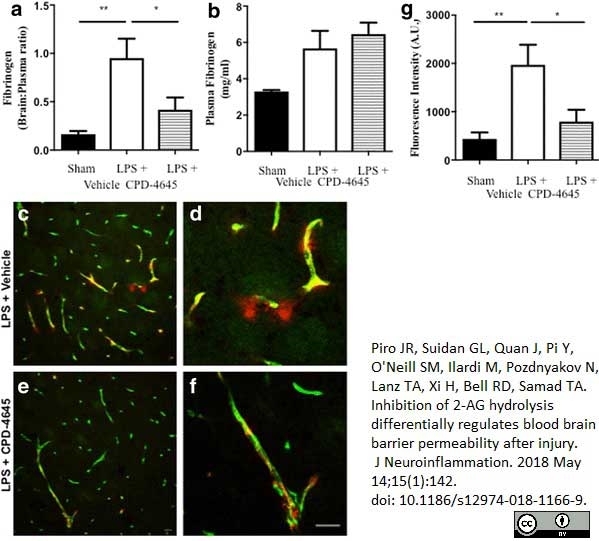Fibrinogen antibody

Sheep anti Human Fibrinogen:FITC
- Product Type
- Polyclonal Antibody
- Isotype
- Polyclonal IgG
- Specificity
- Fibrinogen
| Sheep anti Human fibrinogen antibody recognizes human fibrinogen, a complex ~340 kDa hetero-hexameric (di-trimeric) glycoprotein consisting of 3 pairs of α, β and γ chains linked by a series of 29 disulphide bonds (Henschen et al. 1983). The six chains are arranged in such a way that all the N-Terminal ends adjoin to form a central E domain with two trimeric coiled coil structures connecting to outer D domains. Fibrinogen plays an important role in the coagulation process with the D and E domains interacting via the C-Terminal ends of the α chains during fibrin clot cross-linking. Sheep anti human fibrinogen antibody shows minimal cross-reactivity with related serum proteins. Fibrinogen has been identified as a ferritin binding protein in the horse (Orino et al. 1993). Sheep anti human fibrinogen antibody has been successfully as a capture reagent for ferritin - anti ferritin IgG complexes in horse plasma to evaluate the antibody response to ferritin by ELISA (Takahashi et al. 2013). |
- Target Species
- Human
- Species Cross-Reactivity
-
Target Species Cross Reactivity Mouse Rat - N.B. Antibody reactivity and working conditions may vary between species.
- Product Form
- Purified IgG conjugated to Fluorescein Isothiocyanate Isomer 1 (FITC) - liquid
- Antiserum Preparation
- Antisera to human fibrinogen were raised by repeated immunisations of sheep with highly purified antigen. Purified IgG was prepared from whole serum by affinity chromatography.
- Buffer Solution
- Phosphate buffered saline
- Preservative Stabilisers
0.09% Sodium Azide (NaN3) - Immunogen
- Human fibrinogen purified from plasma.
- Approx. Protein Concentrations
- IgG concentration 1.0mg/ml
- Max Ex/Em
-
Fluorophore Excitation Max (nm) Emission Max (nm) FITC 490 525 - Regulatory
- For research purposes only
- Guarantee
- 12 months from date of despatch
Avoid repeated freezing and thawing as this may denature the antibody. Storage in frost-free freezers is not recommended.
| Application Name | Verified | Min Dilution | Max Dilution |
|---|---|---|---|
| Immunofluorescence | 1/10 | 1/100 |
References for Fibrinogen antibody
-
Grainger, D.J. et al. (2001) Suppressing Thrombin Generation is Compatible With the Development of Atherosclerosis in Mice
Thromb Res. 102: 71-80. -
Grainger, D.J. et al. (2004) Apolipoprotein E modulates clearance of apoptotic bodies in vitro and in vivo, resulting in a systemic proinflammatory state in apolipoprotein E-deficient mice.
J Immunol. 173: 6366-75. -
Plskova, J. et al. (2004) Quantitative evaluation of the corneal endothelium in the mouse after grafting.
Br J Ophthalmol. 88: 1209-16. -
Brill, A. et al. (2011) von Willebrand factor-mediated platelet adhesion is critical for deep vein thrombosis in mouse models.
Blood. 117: 1400-7. -
Barrera, V. et al. (2011) Host fibrinogen stably bound to hemozoin rapidly activates monocytes via TLR-4 and CD11b/CD18-integrin: a new paradigm of hemozoin action.
Blood. 117: 5674-82. -
Takahashi, K. et al. (2013) The presence of heat-labile factors interfering with binding analysis of fibrinogen with ferritin in horse plasma.
Acta Vet Scand. 55: 70. -
Ozaltin, F. et al. (2013) DGKE variants cause a glomerular microangiopathy that mimics membranoproliferative GN.
J Am Soc Nephrol. 24: 377-84. -
Chien, H.W. et al. (2013) Surface conjugation of zwitterionic polymers to inhibit cell adhesion and protein adsorption.
Colloids Surf B Biointerfaces. 107: 152-9.
View The Latest Product References
-
Dmitrieva, N.I. and Burg, M.B. (2014) Secretion of von Willebrand factor by endothelial cells links sodium to hypercoagulability and thrombosis.
Proc Natl Acad Sci U S A. 111: 6485-90. -
Johnsen, D. et al. (2016) Disrupting protein tyrosine phosphatase σ does not prevent sympathetic axonal dieback following myocardial infarction.
Exp Neurol. 276: 1-4. -
Piro, J.R. et al. (2018) Inhibition of 2-AG hydrolysis differentially regulates blood brain barrier permeability after injury.
J Neuroinflammation. 15 (1): 142. -
Huet, F. et al. (2020) Low-dose colchicine prevents sympathetic denervation after myocardial ischemia-reperfusion: a new potential protective mechanism
Future Science OA. : FSO656. -
Sepe, J.J. et al. (2022) Therapeutics That Promote Sympathetic Reinnervation Modulate the Inflammatory Response After Myocardial Infarction.
JACC Basic Transl Sci. 7 (9): 915-30.
Further Reading
-
Kamath, S. & Lip, G.Y. (2003) Fibrinogen: biochemistry, epidemiology and determinants.
QJM. 96 (10): 711-29. -
Mosesson, M.W. (2005) Fibrinogen and fibrin structure and functions.
J Thromb Haemost. 3 (8): 1894-904.
- RRID
- AB_961497
- UniProt
- P02671
- P02675
- P02679
- Entrez Gene
- FGA
- FGB
- FGG
- GO Terms
- GO:0002576 platelet degranulation
- GO:0030674 protein binding, bridging
- GO:0005102 receptor binding
- GO:0007165 signal transduction
- GO:0005577 fibrinogen complex
- GO:0009897 external side of plasma membrane
- GO:0030168 platelet activation
- GO:0031093 platelet alpha granule lumen
- GO:0043499 eukaryotic cell surface binding
- View More GO Terms
- GO:0051258 protein polymerization
- GO:0051592 response to calcium ion
- GO:0051087 chaperone binding
- GO:0005625 soluble fraction
4440-8004F
If you cannot find the batch/lot you are looking for please contact our technical support team for assistance.
Please Note: All Products are "FOR RESEARCH PURPOSES ONLY"
View all Anti-Human ProductsAlways be the first to know.
When we launch new products and resources to help you achieve more in the lab.
Yes, sign me up